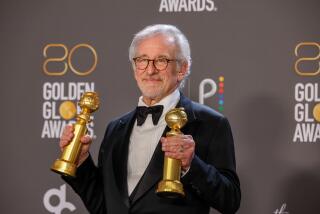Ovation’s growth may be worthy of applause
- Share via
Television may be a vast wasteland, but for the last four years a group of investors has been working to establish an oasis for Ovation, an independent channel devoted to art and contemporary culture.
It’s not easy being a little guy in a land of media giants, lacking leverage and deep pockets. But the Santa Monica-based Ovation has notched impressive gains and is attempting to prove that an arts channel can thrive on TV.
Available in only 5 million homes in 2007, the channel now can be seen in about 42 million homes, or nearly half of all cable and satellite households in the country. Ovation also has bolstered its roster of advertisers — including such marquee companies as Chase Bank, Wal-Mart, Acura and Subaru — and this year the channel swung into the black.
“We are here to build a profitable arts channel. It can be done,” said Charles Segars, a longtime television programmer who is chief executive of Ovation. “The arts have never failed in America, and a whole new generation of artists is formed every day.”
Most cable channels long ago consolidated into the hands of the major players. Only a few independents remain, including the Hallmark Channel, Current TV, the Tennis Channel, the Gospel Music Channel, the Africa Channel and ReelzChannel, owned by Hubbard Media Group, a family firm that was an early investor in DirecTV and is the controlling shareholder of Ovation.
“The track record of true independents has not been very good,” said Ken Solomon, chairman of Ovation, an investor and an architect of the 2006 acquisition of the channel by its current owners for about $55 million. “There are carcasses lining the side of the road to success. We know that distributors — and advertisers — have to see the value of our programming.”
In the early days of cable there were ambitious attempts to create a window into fine arts — symphony, ballet and opera — with the now-defunct Alpha Repertory Television Service and the CBS Cable channel. Next came Arts & Entertainment and Bravo, two networks that eventually abandoned their high-toned missions to chase a broader audience with shows featuring tacky housewives, a bounty hunter named Dog and Gene Simmons, the fire-exhaling rocker in KISS.
Cable operators were initially skeptical that Ovation could remain true to its mission, Solomon said. “There has been a history of leveraging this notion of servicing the creative arts community, only to have companies radically diversify away from their original concept,” he said. “It took a lot of hard work and assurances, both morally and contractually, that we really do believe in this category and that we are in it for the long term.”
Persuading cable operators to carry Ovation has been a challenge. Although the channel is carried by Time Warner Cable, DirecTV and the nation’s largest cable company, Comcast Corp., several major providers have not signed on, including Cox Communications, which serves Orange County and San Diego.
One problem is that, because it’s a stand-alone channel, Ovation doesn’t have the clout to pressure cable operators to add it to their programming lineups. So it has relied on a straightforward pitch: Ovation’s more thoughtful programming is a distinct alternative to the cookie-cutter channels offering movies, sports and reality shows.
“That’s our advantage,” said Segars, who also is an investor. “This is an audience that has been underserved.”
Bowing to the realities of television in an effort to cast a wider net for viewers, however, Ovation applies a more expansive definition to the term “art.” Instead of a strict diet of operas, symphonies and ballet, the channel also shows art-house films and explores photography, architecture and visual arts. It produces several original series, including “Faces of a Vanishing World,” which focuses on a 19-year-old photographer who travels to Ethiopia. The channel runs documentaries, including “The Mona Lisa Curse” and “China Power: Art Now After Mao,” as well as concerts and retrospectives.
If Ovation prospers, it could force a shift in the economics of television. The big profits have long come from entertaining the masses. That’s why Bravo, owned by NBC Universal, ditched its art fare in favor of the likes of “The Real Housewives of New Jersey.”
But now, hundreds of channels chase the same viewers. The “long tail” theory suggests that a greater number of people could be better served through dozens of niche services, such as Ovation, that provide specialized programming.
Andy Klein, president of the cable TV division of Beta Research Corp., said his group’s work corroborates that view. “We have found in our surveys that some of the smaller networks, those that are not well known, often generate significant interest,” Klein said. “And in many cases they have higher levels of viewer satisfaction.”
Ovation has a small programming budget, about $23 million a year, according to consulting firm SNL Kagan. That’s less than what a broadcast network pays to license a season’s worth of one hourlong drama. SNL Kagan estimates that Ovation will generate $51 million this year from advertising and cable affiliate fees. That’s up from $10 million in 2007, the first year the current management team ran the channel.
The Ovation staff has had to be creative with its dollars and has struck partnerships with more than 40 museums across the country. Last year it helped sponsor the Los Angeles County Museum of Art’s weekend film series to keep the program alive. Ovation sponsors free museum days and collaborated on programming.
When the Museum of Contemporary Art in Chicago featured a Jeff Koons exhibit, Ovation agreed to produce a show. The museum used part of Ovation’s program for a video wall for the exhibit. “They understand that our patrons are their audience, so it has been a little of help us, help them, help us,” said Angelique Power, the museum’s communications director.
It is unclear how large of an audience Ovation can depend on. Later this year, that question should be resolved when Ovation is included in the public ratings produced by Nielsen Co.
“It will be interesting to see how they do when they are measured,” said David Scardino, a longtime industry observer who provides research for the Santa Monica advertising firm RPA. But even without ratings, Ovation has been able to attract advertisers.
“They offer a difficult-to-reach demographic, and it tends to be more urban and upscale,” Scardino said.
Ovation’s Segars said that in the coming years he would like to increase the channel’s programming budget, which includes $15 million a year for original productions. The channel would also like to find a breakout hit.
Ovation must find a way to increase its audience without straying too far from its original concept, Scardino said: “The challenge for these specialized networks is that it is always difficult to grow beyond their original core audience.”
meg.james@latimes.com
More to Read
The biggest entertainment stories
Get our big stories about Hollywood, film, television, music, arts, culture and more right in your inbox as soon as they publish.
You may occasionally receive promotional content from the Los Angeles Times.











